It is showering again – raindrops falling in a splashing way, making pitter-patter sounds on my glass window, the odour of wet leaves sops in. Not quite British. The rain in UK is recognisable: it comes suddenly but gently, no shelter is needed, no sound can be heard, and mostly in an hour, it fades away. Just like the rain there, the country about 9000 kilometres far from where I am, leaves its visitors an impression which is modest but full of surprise.
From 17 July to 4 August in 2017, as it's written on the handbook by Birmingham International Summer School, we explored the art, literature, music, design and popular culture that form the basis of Britain’s culture and heritage and continue to shape its identity today. British Culture Heritage being the program with the most off-campus trips, it let us complete our course not only by listening to professors’ lectures and looking at the illustrations on the PowerPoint, but also by visiting the sites and comprehending the local knowledge personally.
One of the spots is the University of Cambridge. The renowned Cambridge is not as solemn as I’ve imagined due to its long history.
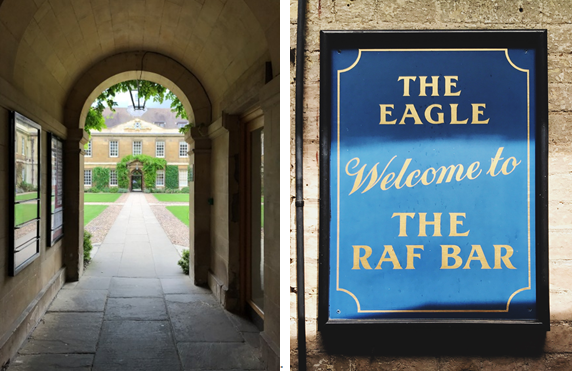
Colleges are surrounded by stores, pubs and churches. Every college looks like a private garden. Just as in our campus, bicycles are placed against walls, free for students’ daily short commute.
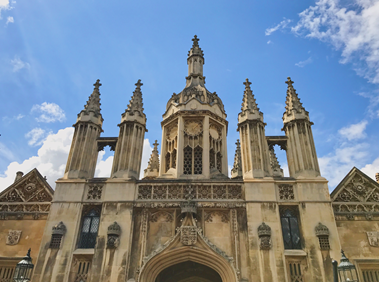
The University of Oxford is similar in some paralysing way, but is contained in a large city rather than a small country town. Its presence is not obvious as Cambridge. According to Dr John Carman, each of the two refers to the other as ‘the Other Place’; they only recognise as universities each other, London and Trinity College Dublin; and there are days students must wears a gown but no tie, suit or dress when in a gown. The traditions existing in these universities represent the characters of Britain’s top education: competitive, elite and never rigid.
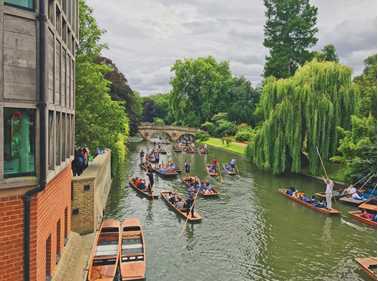
You can be in the library doing academic work; likewise, you can go punting on the river, wander the streets of the town or enjoy a Shakespeare play by students. The university will never restrain you, you are all by yourself.

The Pitt Rivers Museum is the University of Oxford’s museum of anthropology and world archaeology. Founded in 1884 following a gift to the university from general Pitt Rivers, it retains its unique atmosphere with dense displays of artefacts, many in the original wooden display cabinets. Interesting exhibits can be seen in the museum.
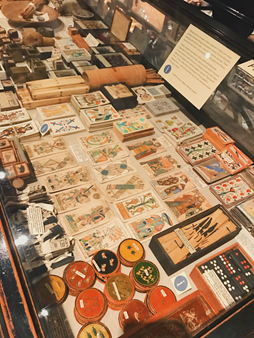
It is a usual scene to see that parents take their children to the museum and hold a piece of treasure map, encouraging their curious son or daughter to search the place thoroughly and find their target exhibit. Museums seem to be a choice of British people’s family time. As far as I’ve seen, they truly enjoy themselves and gain from the cultural heritages.
Liverpool is my favourite among all the places I visited in England this time. Located on the eastern side of the Mersey Estuary and thrived as a world major port, Liverpool is often compared with Shanghai.
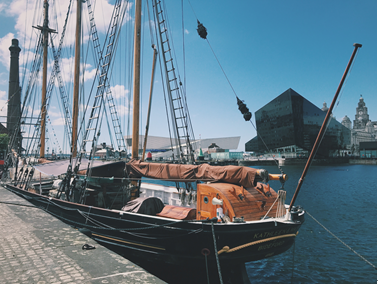
However, Liverpool’s charm lies not in its resemblance to Shanghai. It’s ancient as it became a borough in 1207 and a city in 1880; but it’s also young since it’s still undergoing regeneration. The historical city of Liverpool had a great influence on British Cultural Heritage. It showed visitors its experience and achievements in protecting its port and surrounding waterways as part of the city's revival.
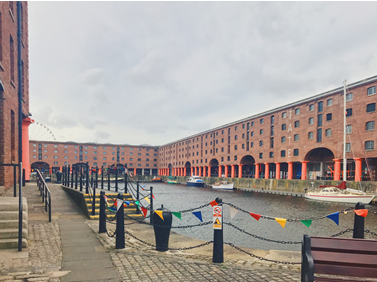
Thanks to this effort, many of Liverpool's historical buildings and areas have been protected and renovated, including Albert Harbour, Rope Walks and St. George's Hall, which have all brought significant economic benefits to the city.
For me, Liverpool is a lively place. Near Pier Head, there was a fairground contains recreational facilities like Turbo Drop, merry-go-round and Ferris wheel.
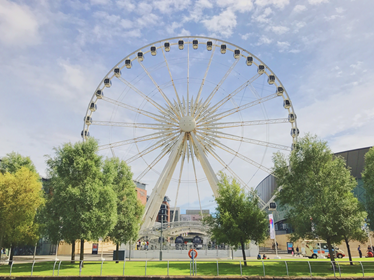
Echoes of laughter and scream generated there went across the street, before reaching Port of Liverpool Building, they were shut out by its front gate.

The inside of the building is lively as well. Walking into the entrance is a huge room reaching right up into the dome. Marble columns and Edwardian balconies make it look professional. Nowadays the building is filled with offices that have little to do with maritime matters; officers are going up and down and needless to say, all in good order. When I headed toward the centre of Liverpool, things became more attractive.

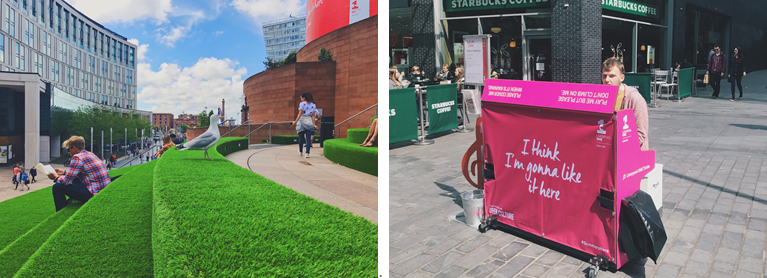
It was sunny that day, people were playing table tennis by the tables placed in every corner of Liverpool; readers and families were sitting on the steps of terrace with plush greens near Starbucks and enjoying the sun; music players and amateurs were performing on the six pianos throughout Liverpool ONE.
If you take a glance at the museums there, you will find that even they’ve already accustomed themselves to modern life, people do not stop reflecting the past.
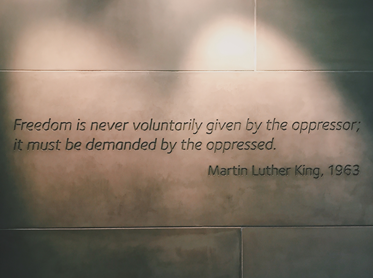
Merseyside Maritime Museum and Slavery Museum at Albert Dock are classical cases – there are exhibitions about animal hunting, environmental pollution and slave trade. Curators also designed interactive games in the museum for children to understand the history more vividly.

We had a two day field trip with an overnight stay to the Ironbridge Gorge World Heritage Site, birthplace of the Industrial Revolution and home to the world’s first major iron bridge. Ironbridge is always referred to as a living heritage as it’s still residence of the local. It’s made up of 10 museums operated by the Ironbridge Gorge Museum Trust. Our trip included the Coalbrookdale Museum of Iron, the Old Furnace, the Ironbridge, Coalport China Museum, Jackfield Tile Museum and Blists Hill Victorian Hall. In them, Blists Hill Victorian Hall is of the most sense of participation.
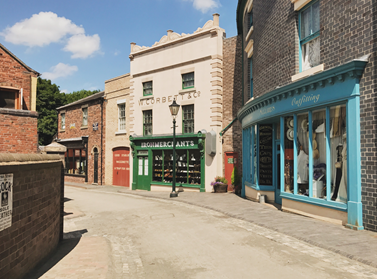
The town is an open-air museum built on a former industrial complex located in the Madeley area of Telford, Shropshire, England. The slogan on the homepage of Blists Hill Victorian Hall writes, ‘Rocket yourself back to the age of steam and experience the sights, sounds and smells of the Victorian age.’ As it suggests, the museum attempts to recreate everything of a Victorian Shropshire town in the late 19th and early 20th centuries.

No cars or TV can be seen there. Visitors experience what life was like when Britain ruled the world. Victorians played by costumed demonstrators work in their authentic stores and live in cottages. They have been trained in the skills and history of the profession they re-enact and normally talk in the third person, referring to the Victorians as ‘they’ or ‘them’.

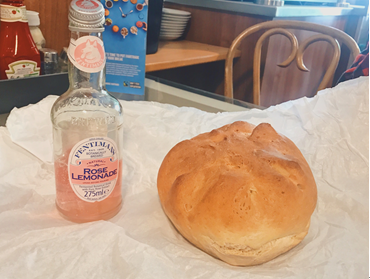
All sorts of curious goods from a bygone era can be bought in stores. Ask any question you come up with and you will get a satisfying answer. Near the entrance is a bank where modern money can be changed into old coins that are currency in use in the small town till now.
Everybody thinks of the name of William Shakespeare at the mention of English literature and his birthplace Stratford-upon-Avon, a medieval market town in England’s West Midlands, is a regular tourism destination. The two houses, Shakespeare’s Birthplace and New Place are the most popular spots in the town.

In Shakespeare’s Birthplace, the shabby house provides public access. The inside has a typical layout of an ordinary family in Elizabethan age. At the back of the house is a walled garden with a small round stage in the centre.

At set intervals, Shakespearean actors and actresses play a scene from a Shakespeare’s drama according to audience’s request. After watching the live Taming of the Shrew, Antony and Cleopatra (I requested it) and Romeo & Juliet, we left the place. It is different from the Shakespeare drama in our university. All performers are professional and remember every line of the play so deep in their minds that can be recalled in the turn of the hand.

Then we left for Shakespeare’s New Place. It was his family home from 1597 until he died in the house in 1616. The house was demolished in 1759, a registered garden has been designed to commemorate the importance of the site. Lines from his drama are inscribed on the gate, chair, statue and other places in the garden, allowing visitors to make their own personal connection with Shakespeare.
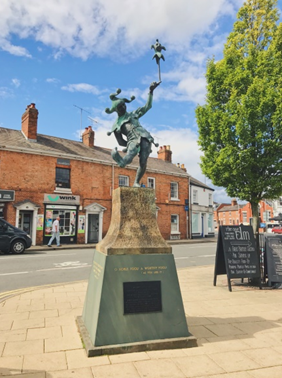
As Shakespeare said, ‘All the world’s a stage, and all men and women merely players’, his dramas created a broad stage for all of his readers to experience the seven ages of acting beforehand. Everyone finds a role being the epitome of his or her life. Even though some plots are too fanciful to happen in reality, we benefit from the growth of the characters. Maybe that’s the reason why people love Shakespeare and give his birthplace the name of ‘a Mecca for all lovers of literature’.
Developed from a cluster of small villages into a manufacturing powerhouse and one of the UK’s most diverse cultural hubs, Birmingham itself is also a sight to see, with the centre decorated by large fancy stores, all over the city scattered museums, galleries and other heritage sites, and canals designed long before weaving an intricate water transport network.

When first entered the campus of Birmingham University, I was attracted by a big bear sculpture standing in front of the library. After asking student ambassador, I recognized that it is a part of Birmingham’s big public art trail named ‘the Big Sleuth’. It features more than 100 bear sculptures in the city’s streets, parks and open spaces.

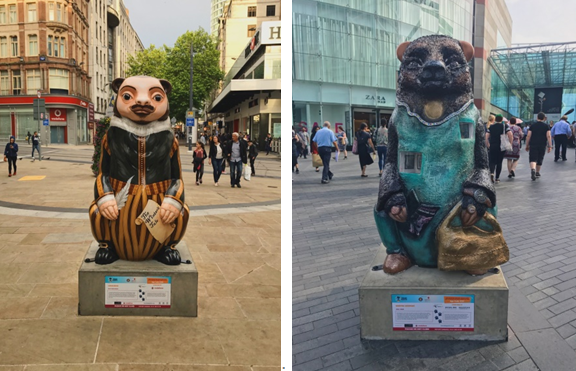
The Bear-mingham city showed its creativity by arts like this. History, tradition, culture and modern elements are combined together by mass art activity. In spite of new creations, old heritage conservation and management is equally significant, and British people did it well too.
In a lecture given by Dr Ioanna Katapidi, she said that the concept heritage is an evolving one – it evolved from an object to a process which includes selection, interpretation and relevant transformations from the contemporary society. The Roundhouse by the bank of the canal perfectly exemplified this point.

Hearing the name of Roundhouse, what people find about this 19 century stable and store might be its historical and physical value – the unique style and shape being the result of a design competition organized by Birmingham Corporation. But no one will have an accurate estimate of what it’s like inside. After getting into the house and knowing its transformation plan to change the at-risk building into a base combining leisure and enterprise, people realize its associative value and begin to understand the importance of it and other heritage buildings alike. What we heard, we imagined, we saw and understood, none of them appeared to be identical with each other. Values being the criteria of heritage selection, what to tell and show being interpretation and how to adapt it with the recent society being transformation, perhaps it is because of the dynamic process that creates this disparity.
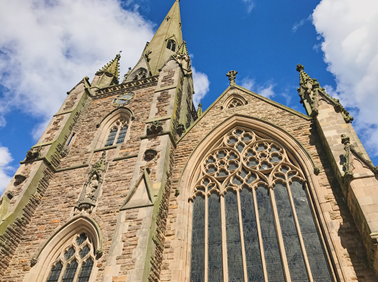
In UK, people take hold of the view that development can never separate from the past. The best approach to do it is restoring your history, keeping your buildings and culture, and making sure that is part of your future development – not just destroy buildings, take them away and build new ones, but maintain the past.
Britain is a country where mere acquaintances smile to each other whenever they have eye contact; where you can be ‘darling’ and ‘sweet heart’ in anybody’s greeting, no matter it’s from a granny or a granddad, a lady or a gentleman. It is in this country that those modest and creative people formed civilization just like them, and keep inheriting and innovating in their own surprising and gentle way.